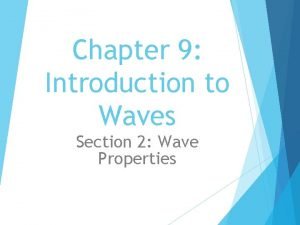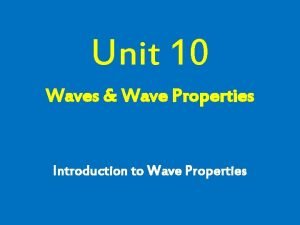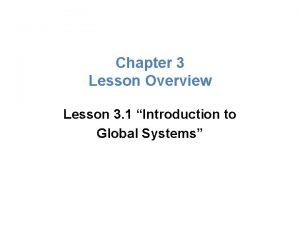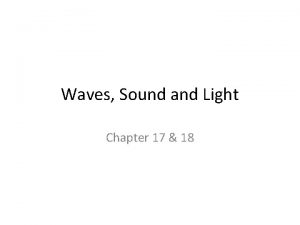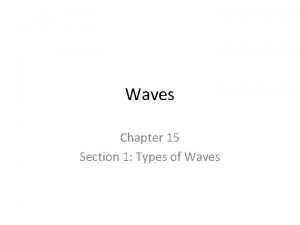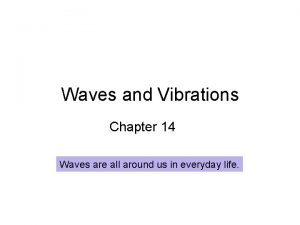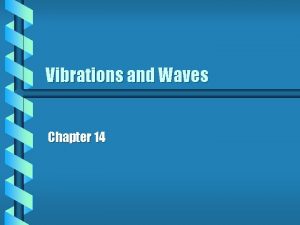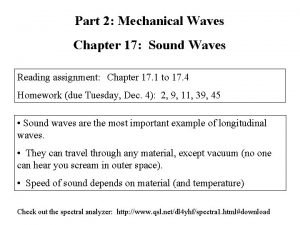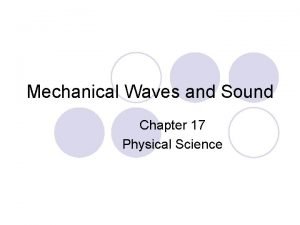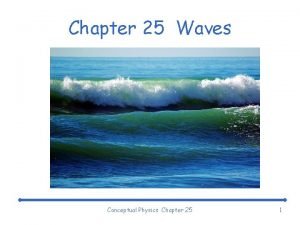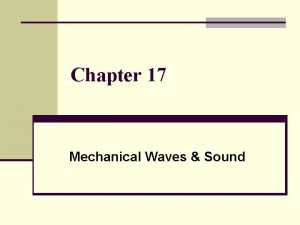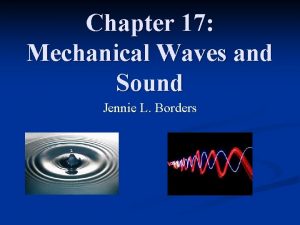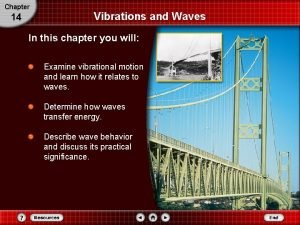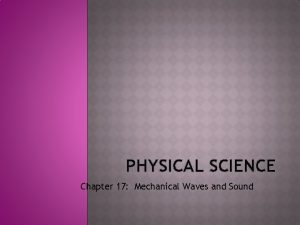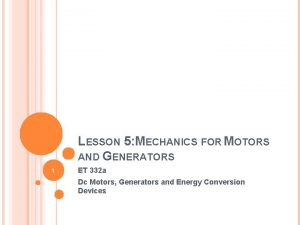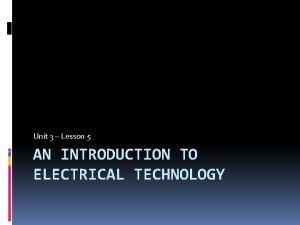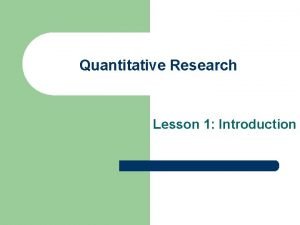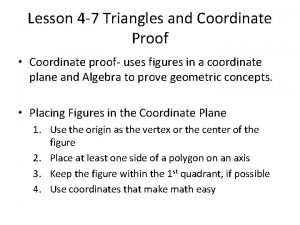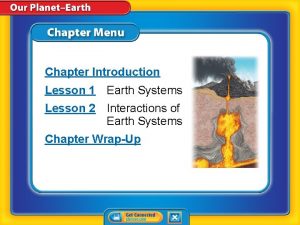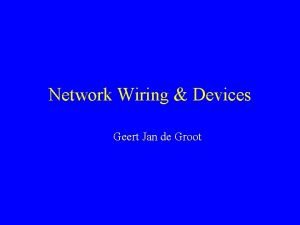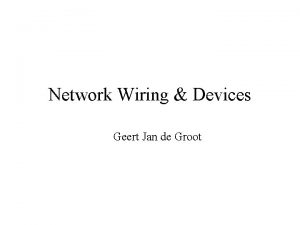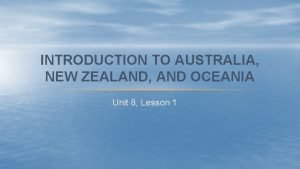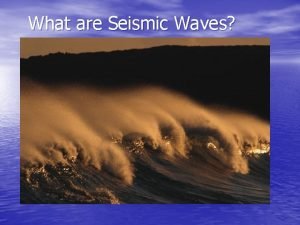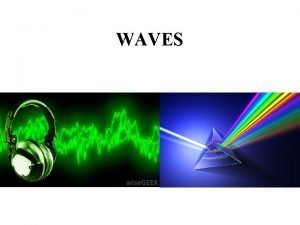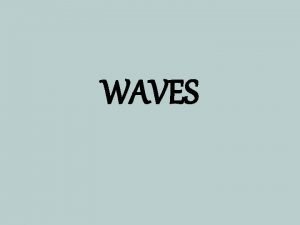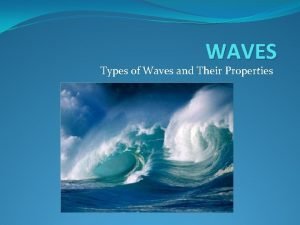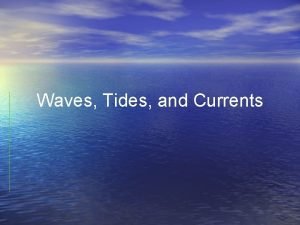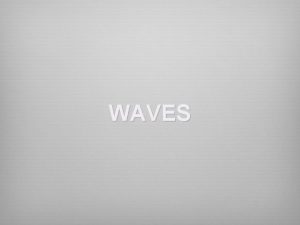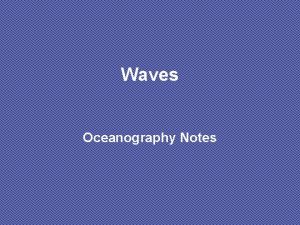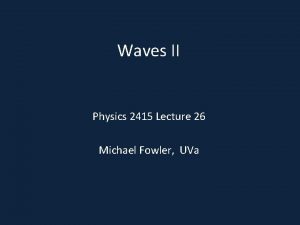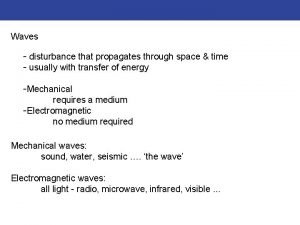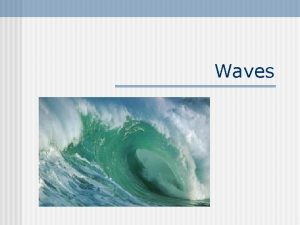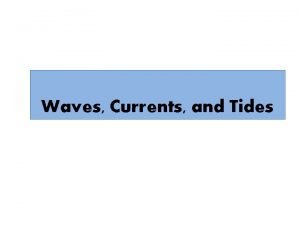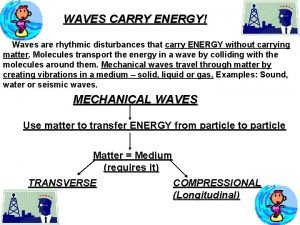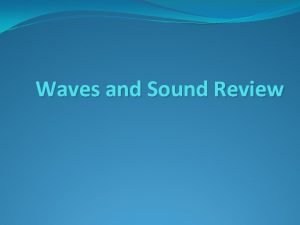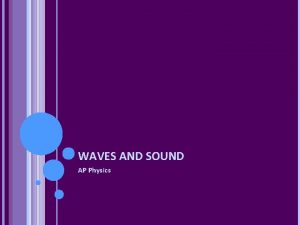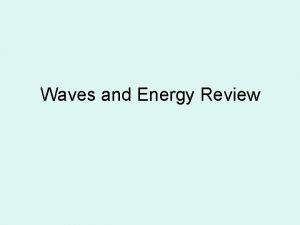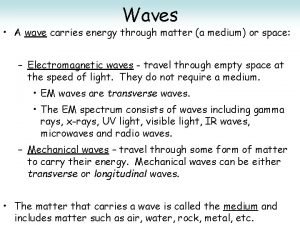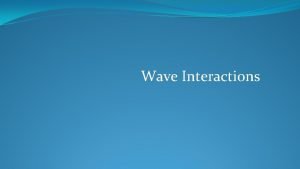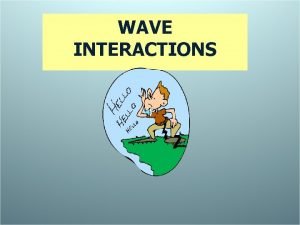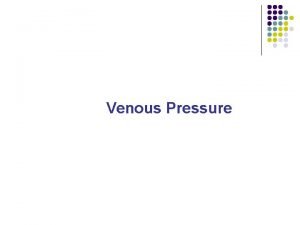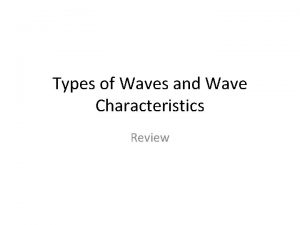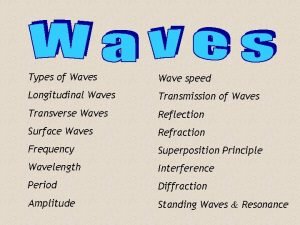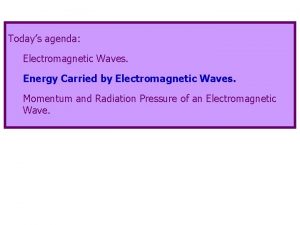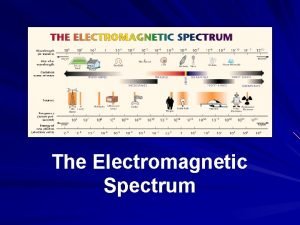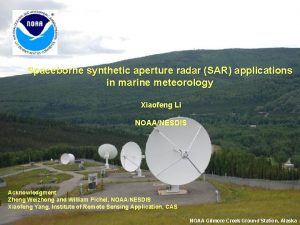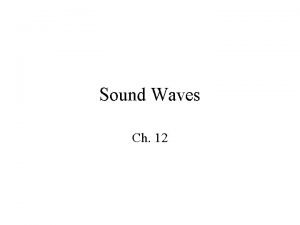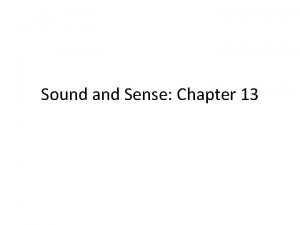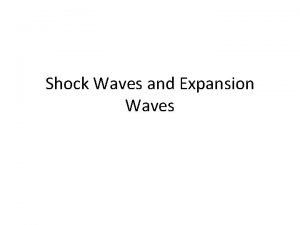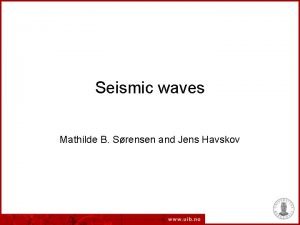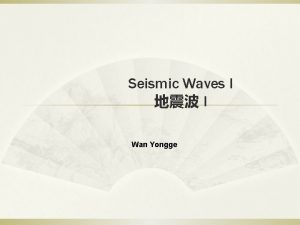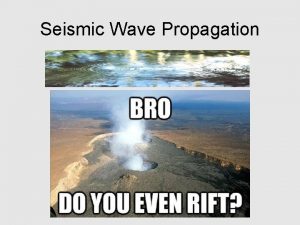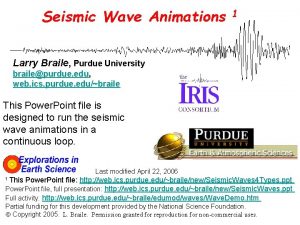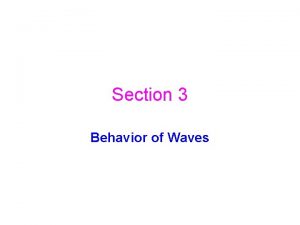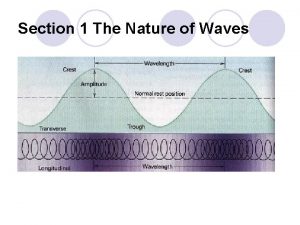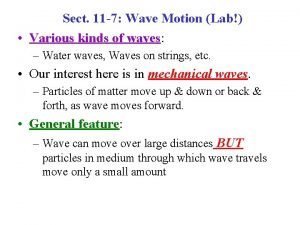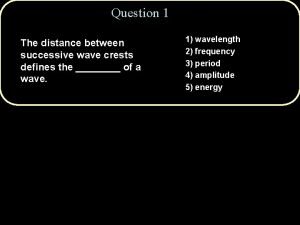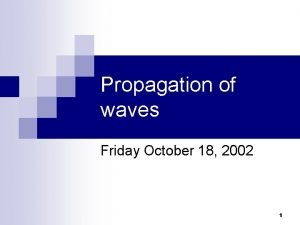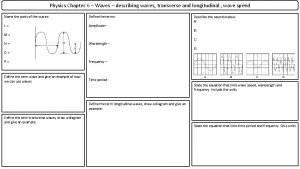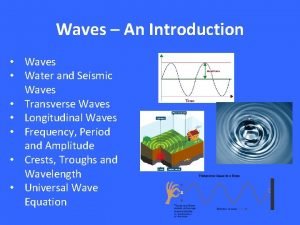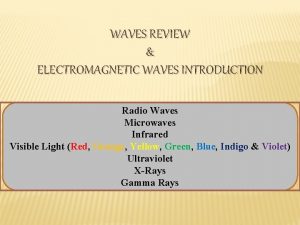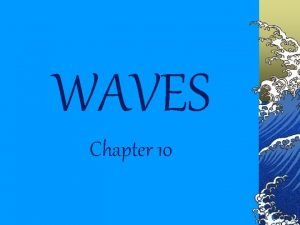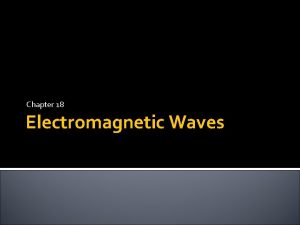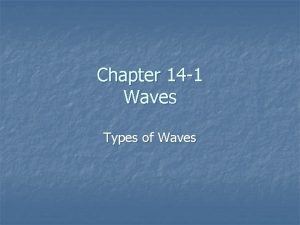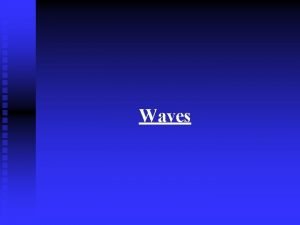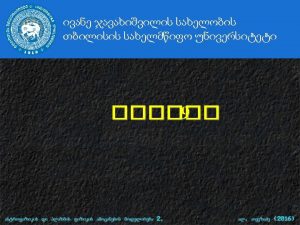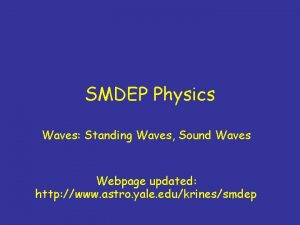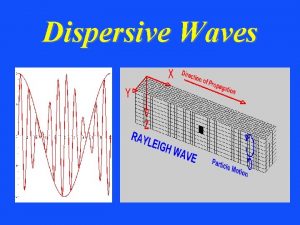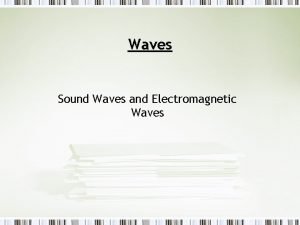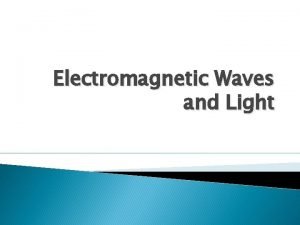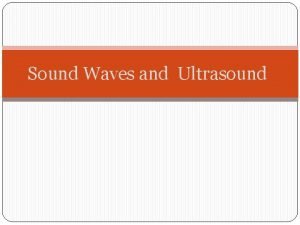Chapter Introduction Lesson 1 What are waves Lesson










































































































- Slides: 106

Chapter Introduction Lesson 1 What are waves? Lesson 2 Wave Properties Lesson 3 Wave Interactions Chapter Wrap-Up

How do waves travel through matter?

What do you think? Before you begin, decide if you agree or disagree with each of these statements. As you view this presentation, see if you change your mind about any of the statements.

Do you agree or disagree? 1. Waves carry matter as they travel from one place to another. 2. Sound waves can travel where there is no matter. 3. Waves that carry more energy cause particles in a material to move a greater distance.

Do you agree or disagree? 4. Sound waves travel fastest in gases, such as air. 5. When light waves strike a mirror, they change direction. 6. Light waves travel at the same speed in all materials.

What are waves? • What is a wave? • How do different types of waves make particles of matter move? • Can waves travel through empty space?

What are waves? • trough • wave • mechanical wave • medium • transverse wave • crest • longitudinal wave • compression • rarefaction • electromagnetic wave

What are waves? • A _______ is a disturbance that transfers energy from one place to another without transferring matter. • Waves ____ energy away from the source of the energy. • Waves leave matter in the same place after they pass.

What are waves? (cont. ) What is a wave?

Water waves transfer energy across the pool, but not matter. As a result, the raft does not move along with the waves.

Water waves transfer energy across the pool, but not matter. As a result, the raft does not move along with the waves.

Mechanical Waves • A wave that can travel only through matter is a ______ wave. • Mechanical waves cannot move through a ______. • A material in which a mechanical wave travels is called a _____.

Mechanical Waves (cont. ) • A _____ wave makes particles in a medium move at right angles, or perpendicular, to the direction the wave travels. • The highest points on a transverse wave are _____. • The lowest points on a transverse wave are ______.

In a ____ wave, particles move at _______ angles to the direction the wave travels.

Mechanical Waves (cont. ) How do particles move in a transverse wave?

Mechanical Waves (cont. ) • A _____ wave makes the particles in a medium move _____ to the direction that the wave travels. • The regions of a longitudinal wave where the particles in the medium are closest together are _______. • The regions of a longitudinal wave where the particles are farthest apart are ________.

Longitudinal Waves

Longitudinal Waves

Mechanical Waves (cont. ) How do particles move in a longitudinal wave?

Mechanical Waves (cont. ) • A _____ is a back-and-forth or an up-and-down movement of an object. • Vibrating objects are the sources of energy that produce mechanical waves.

Vibrations produce waves that keep traveling even when the vibrations stop.

Vibrations produce waves that keep traveling even when the vibrations stop.

Types of Mechanical Waves • All mechanical waves travel only in _______. • Sound waves and waves produced by earthquakes are mechanical waves that travel in different mediums.




Electromagnetic Waves An ______ wave can travel through a vacuum and through matter. electromagnetic from Greek elektron, means “amber” and magnes, means “lodestone”

Electromagnetic Waves (cont. ) Light is an _______ wave. Identify a type of wave that can travel through a vacuum.

Electromagnetic Waves (cont. ) • Other types of electromagnetic waves include _____ waves, ________ waves, and _____ waves. • Every object gives off electromagnetic waves. • Humans and other objects near human body temperature also give off mostly _____ waves.

Electromagnetic Waves (cont. ) • Electromagnetic waves carry energy that scientists call _____ energy. • _____ and _____ light waves carry about 92 percent of the radiant energy that reaches Earth from the Sun. • _____ waves carry about 7 percent of the Sun’s energy.

• Waves, such as those from a burning candle, the Sun, or a loudspeaker, transfer energy away from the source of the wave. • A transverse wave makes particles in a medium move at right angles to the direction of the wave.

• A longitudinal wave makes the particles in a medium move in a direction that is parallel to the direction the wave travels.

Which term refers to the highest points on a transverse wave? A. trough B. rarefaction C. medium D. crest

Which can be described as a wave that can travel only through matter? A. transverse wave B. mechanical wave C. longitudinal wave D. electromagnetic wave

Which is the only type of wave that can travel through a vacuum? A. electromagnetic wave B. longitudinal wave C. mechanical wave D. transverse wave

Do you agree or disagree? 1. Waves carry matter as they travel from one place to another. 2. Sound waves can travel where there is no matter.

Wave Properties • What are the properties of waves? • How are the frequency and the wavelength of a wave related? • What affects wave speed?

Wave Properties • amplitude • wavelength • frequency

Amplitude and Energy The ______ of a transverse wave is the maximum distance the particles in a medium move from their rest position as the wave passes. amplitude from Latin amplitudinem, means “width”

The amplitude of a transverse wave is the distance from the _______ position to a ____ or a ______.

The larger the amplitude, the more ______ the wave carries and vice versa.

The wave with the larger _______ carries more _____ and makes the ball bounce _____, and vice versa.

Amplitude and Energy (cont. ) • The amplitude of a longitudinal wave depends on the distance between particles in the ______ and ______. • When the amplitude of a longitudinal wave increases, the particles in the medium get _____in the compressions and ____ apart in the rarefactions.

The amplitude of a longitudinal wave on a spring depends on the spacing of the coils in the compressions and rarefactions.

Wavelength • The ______ of a wave is the distance from one point on a wave to the nearest point just like it. • Wavelength is measured in units of distance, such as ____.

To measure the wavelength of a transverse wave, you can measure the distance from one _______ to the next _______ or from one _______ to the next _____.

To measure the wavelength of a longitudinal wave, you can measure the distance from one _____ to the next ______ or from one ____ to the next ______.

Frequency • The _____ of a wave is the number of wavelengths that pass by a point each second. • _____ is related to how rapidly the object or material producing the wave vibrates. • Each vibration of the object produces one _____.

Frequency (cont. ) What are three properties of waves?

Frequency (cont. ) • The frequency of a wave is the same as the number of ____ the vibrating object makes each second. • The SI unit for frequency is _______. • To calculate the frequency of waves, divide the _____ of wavelengths by the _____. • As the frequency of a wave increases, the wavelength ______, and opposite is true

Frequency and Wavelength

Frequency (cont. ) How does the wavelength change if the frequency of a wave decreases? What if the frequency increases?

Wave Speed • Different types of waves travel at ____ speeds. • The same type of waves travel at _____ speeds in different materials. • Temperature also affects the ____ at which waves travel.

Wave Speed (cont. ) What does wave speed depend on?

Wave Speed (cont. ) You can calculate the speed of a wave by multiplying its _____ and its ______ together.

Wave Speed (cont. )

• The amplitude of a transverse wave is the maximum distance the particles in a medium move from the rest position.

• The wavelength of a transverse wave is the distance from one point on a wave to the nearest point just like it, such as from crest to crest or from trough to trough.

• The wavelength of a longitudinal wave is the distance from one point on a wave to the nearest point just like it, such as from compression to compression or from rarefaction to rarefaction.

To measure the wavelength of a transverse wave, you can measure the distance from one crest to which of these? A. the next crest B. the next trough C. the next compression D. the next rarefaction

Which refers to the number of wavelengths that pass by a point each second? A. amplitude B. compression C. frequency D. wavelength

What can you calculate by multiplying wavelength and frequency? A. amplitude B. vibration C. wave height D. wave speed

Do you agree or disagree? 3. Waves that carry more energy cause particles in a material to move a greater distance. 4. Sound waves travel fastest in gases, such as air.

Wave Interactions • How do waves interact with matter? • What are reflection, refraction, and diffraction? • What is interference?

Wave Interactions • absorption • refraction • transmission • diffraction • reflection • interference • law of reflection

Interaction of Waves with Matter • Waves can be reflected by matter or they can change direction when they travel from one material to another. • As waves pass through matter, some of the energy they carry can be transferred to matter.

Interaction of Waves with Matter (cont. ) • _______ occurs when energy carried by a wave transfers to the material in which it is traveling. • The amount of energy absorbed depends on the _______ of wave and the _____ in which it moves. • All materials absorb _____ waves, although some materials absorb more electromagnetic waves than others.

Interaction of Waves with Matter (cont. ) ______ occurs when waves pass through a material.

Interaction of Waves with Matter (cont. ) • ______ occurs when waves bounce off the surface of a material. • An object that reflects all visible light would appear _____, while an object that reflects no visible light would appear _____. • All types of waves, including sound waves, light waves, and water waves, can reflect when they hit a surface.

Interaction of Waves with Matter (cont. ) What are three ways that waves interact with matter?

The Law of Reflection • A line that is perpendicular to a surface is called the normal. • The angle between the direction of the incoming wave and the normal is the angle of ______. • According to the law of reflection, the angle between the direction of the reflected wave and the normal is the angle of ______.

According to the _______, the angle of incidence equals the angle of reflection for all waves.

The Law of Reflection (cont. ) normal Science Use perpendicular to or forming a right angle with a line or plane Common Use conforming to a standard or common

Refraction • Sometimes waves change direction even if they are not reflected from a surface. • _____ occurs when a wave changes direction because its speed changes. • The greater the change in speed, the more the wave changes _____.

The beam of light changes direction because light waves slow down as they move from air into water.

Refraction (cont. ) refraction from Latin refractus, means “to break up”

Diffraction • Waves can change direction as they travel by objects. • The change in direction of a wave when it travels by the edge of an object or through an opening is called ______. • The wavelengths of sound waves are similar in size to many common objects.

Diffraction (cont. ) Compare and contrast reflection, refraction, and diffraction.

Interference • In addition to interacting with matter, waves also interact with each other. • ______ occurs when waves that overlap combine to form a new wave. • After waves travel through each other, they keep moving without having been changed.

Wave Interference When waves interfere with each other, they create a ______ wave that has a different _______ than either original wave. It could be ____ or_____

Wave Interference

Interference (cont. ) • As waves travel through each other, sometimes the crests of both waves overlap, forming a new wave with greater amplitude than either of the original waves. • This type of interference is called ______ interference.

Interference (cont. ) • Destructive interference occurs when a crest of one wave overlaps the ______ of another wave. • The new wave that forms has a ____ amplitude than the sum of the amplitudes of the original waves.


Interference (cont. ) Describe two types of wave interference.

• Transmission occurs when waves travel through a material.

• Reflection occurs when waves bounce off the surface of a material. • The change in direction of a wave when it travels through an opening is diffraction.

Which occurs when a wave changes direction because its speed changes? A. diffraction B. interference C. reflection D. refraction

Which occurs when waves that overlap combine to form a new wave? A. diffraction B. interference C. reflection D. refraction

According to the law of reflection, the angle of incidence equals which of these? A. the angle of refraction B. the angle of reflection C. the angle of interference D. the angle of diffraction

Do you agree or disagree? 5. When light waves strike a mirror, they change direction. 6. Light waves travel at the same speed in all materials.

Key Concept Summary Interactive Concept Map Chapter Review Standardized Test Practice

Waves transfer energy but not matter as they travel. Waves, such as light waves and sound waves, move at different speeds in different materials.

Lesson 1: What are waves? • Vibrations cause waves. • Transverse waves make particles in a medium move at right angles to the direction that the wave travels. Longitudinal waves make particles in a medium move parallel to the direction that the wave travels. • Mechanical waves cannot move through a vacuum, but electromagnetic waves can.

Lesson 2: Wave Properties • All waves have the properties of amplitude, wavelength, and frequency. • Increasing the frequency of a wave decreases the wavelength, and decreasing the frequency increases the wavelength. • The speed of a wave depends on the type of material in which it is moving and the temperature of the material.

Lesson 3: Wave Interactions • When waves interact with matter, absorption and transmission can occur. • Waves change direction as they interact with matter when reflection, refraction, or diffraction occurs. • Interference occurs while waves that overlap combine to form a new wave.

Which type of wave makes particles in a medium move at right angles to the direction the wave travels? A. longitudinal wave B. mechanical wave C. seismic wave D. transverse wave

Which term describes the backand-forth or up-and-down movement of an object? A. compressions B. crests C. troughs D. vibrations

Which describes the maximum distance the particles in a medium move from their rest position as the wave passes? A. a wave’s wavelength B. a wave’s speed C. a wave’s frequency D. a wave’s amplitude

What happens to the particles in the compressions when the amplitude of a longitudinal wave increases? A. B. C. D. They get closer together. They get further apart. They are unchanged. They cannot be measured.

Which occurs when energy carried by a wave transfers to the material in which it is traveling? A. absorption B. reflection C. refraction D. transmission

Which is the source of energy that produce all mechanical waves? A. water B. vibrating objects C. troughs D. crests

Which describes a material in which a mechanical wave travels? A. crest B. medium C. rarefaction D. trough

Every object gives off which of these? A. electromagnetic waves B. longitudinal waves C. mechanical waves D. transverse waves

Each vibration of an object produces which of these? A. one compression B. one rarefaction C. one wavelength D. two wavelengths

Which term refers to what happens when waves bounce off the surface of a material? A. absorption B. reflection C. refraction D. transmission
 Mikael ferm
Mikael ferm Lesson 1 introduction to waves
Lesson 1 introduction to waves Low amplitude wave
Low amplitude wave Sound waves are longitudinal waves true or false
Sound waves are longitudinal waves true or false Mechanical wave
Mechanical wave How are rainbows made
How are rainbows made What type of waves are sound waves? *
What type of waves are sound waves? * Is echolocation transverse or longitudinal
Is echolocation transverse or longitudinal What is a semiconductor used for
What is a semiconductor used for Difference between matter waves and electromagnetic waves
Difference between matter waves and electromagnetic waves Electromagnetic waves vs mechanical waves
Electromagnetic waves vs mechanical waves Mechanical waves and electromagnetic waves similarities
Mechanical waves and electromagnetic waves similarities Seismic waves
Seismic waves Is a seismic wave mechanical or electromagnetic
Is a seismic wave mechanical or electromagnetic Compare and contrast p waves and s waves using venn diagram
Compare and contrast p waves and s waves using venn diagram What do all waves transmit
What do all waves transmit Difference between constructive and destructive waves
Difference between constructive and destructive waves Chapter 9 introduction to waves
Chapter 9 introduction to waves Which wave
Which wave Lesson 1 what are waves answer key
Lesson 1 what are waves answer key Chapter 3 lesson 1 introduction to global systems
Chapter 3 lesson 1 introduction to global systems Characteristics of mechanical waves
Characteristics of mechanical waves Chapter 15 section 1 types of waves answer key
Chapter 15 section 1 types of waves answer key The wave chapter 14
The wave chapter 14 Chapter 14 vibrations and waves
Chapter 14 vibrations and waves Chapter 17 mechanical waves and sound wordwise answer key
Chapter 17 mechanical waves and sound wordwise answer key Chapter 17 physical science
Chapter 17 physical science Bow wave aircraft
Bow wave aircraft Types of mechanical waves
Types of mechanical waves Mechanical waves and sound
Mechanical waves and sound Chapter 14 vibrations and waves answers
Chapter 14 vibrations and waves answers The wave chapter 10
The wave chapter 10 Chapter 17 mechanical waves and sound
Chapter 17 mechanical waves and sound An overall state of well-being or total health
An overall state of well-being or total health Conclusion paragraph format
Conclusion paragraph format The last lesson introduction
The last lesson introduction Torque mechanics
Torque mechanics Lesson 5: introduction to electrical devices
Lesson 5: introduction to electrical devices What is scientific research
What is scientific research 4-8 triangles and coordinate proof
4-8 triangles and coordinate proof Lesson 1 introduction to ecology answer key
Lesson 1 introduction to ecology answer key Lesson 3.1 introduction to data collection
Lesson 3.1 introduction to data collection Lesson 1: introduction to the earth
Lesson 1: introduction to the earth A christmas carol introduction lesson
A christmas carol introduction lesson Lesson 7: introduction to wiring devices
Lesson 7: introduction to wiring devices Geert jan de groot
Geert jan de groot Lesson 8 introduction to firestopping
Lesson 8 introduction to firestopping Lesson 1: an introduction to oceania
Lesson 1: an introduction to oceania Surface wave
Surface wave Parts of the waves with label
Parts of the waves with label A rhythmic disturbance that transfers energy
A rhythmic disturbance that transfers energy Medium waves
Medium waves Electromagnetic waves vocabulary
Electromagnetic waves vocabulary Different types of waves
Different types of waves Crest in waves
Crest in waves When waves overlap it is called
When waves overlap it is called Anatomy of a wave
Anatomy of a wave Draw and label transverse wave
Draw and label transverse wave All wave carry
All wave carry Standing wave equation
Standing wave equation Describing waves
Describing waves Transverse vs longitudinal waves
Transverse vs longitudinal waves Study jams waves and currents
Study jams waves and currents Rhythmic disturbances that carry energy
Rhythmic disturbances that carry energy Rhythmic disturbances that carry energy
Rhythmic disturbances that carry energy Transverse waves for kids
Transverse waves for kids Three waves a b and c travel 12 meters in 2.0 seconds
Three waves a b and c travel 12 meters in 2.0 seconds Ap physics waves
Ap physics waves What do all waves have in common
What do all waves have in common Type of wave
Type of wave Wavelength constructive interference
Wavelength constructive interference Waves can undergo
Waves can undergo Waves transfer energy without transferring
Waves transfer energy without transferring How to measure jvp
How to measure jvp Rossby waves
Rossby waves Wave interactions
Wave interactions Sound waves from a radio generally travel in which medium?
Sound waves from a radio generally travel in which medium? Wave list
Wave list Em wave energy density
Em wave energy density Aceleration
Aceleration Normal pr segment
Normal pr segment Electromagenetic spectrum
Electromagenetic spectrum Peristaltic waves
Peristaltic waves Waves produced by stars and galaxies
Waves produced by stars and galaxies Sound waves spelling word lists
Sound waves spelling word lists Atmospheric gravity waves
Atmospheric gravity waves Sonic spectrum definition
Sonic spectrum definition Library.thinkquest.org 19537
Library.thinkquest.org 19537 Phonetic intensives
Phonetic intensives Oblique shock angle
Oblique shock angle Send waves of support
Send waves of support Thereforw
Thereforw Text book
Text book What are wavefronts
What are wavefronts Seismic waves
Seismic waves P wave animation
P wave animation Section 3 the behavior of waves
Section 3 the behavior of waves Ability of two or more waves to combine and form a new wave
Ability of two or more waves to combine and form a new wave Scalar waves
Scalar waves The electromagnetic spectrum song lyrics
The electromagnetic spectrum song lyrics Distance between two wave crests
Distance between two wave crests Kesler science sound waves answer key
Kesler science sound waves answer key Example of longitudinal wave
Example of longitudinal wave The basic properties of waves are
The basic properties of waves are Spherical waves equation
Spherical waves equation Wave notes pdf
Wave notes pdf Describing waves
Describing waves

















